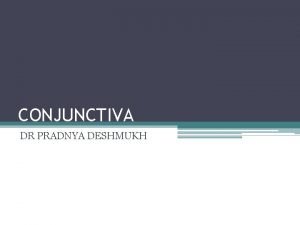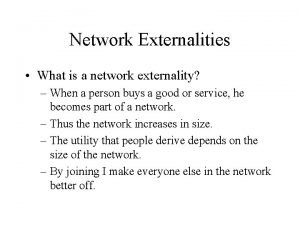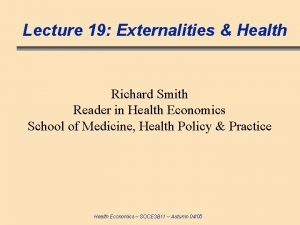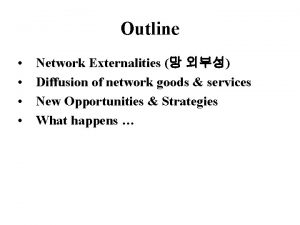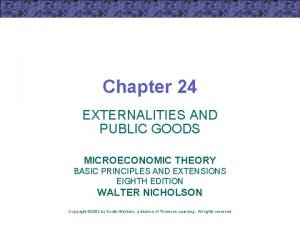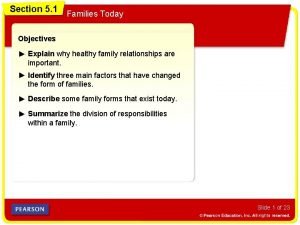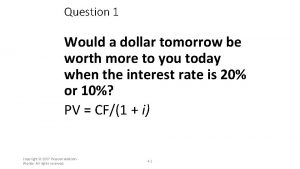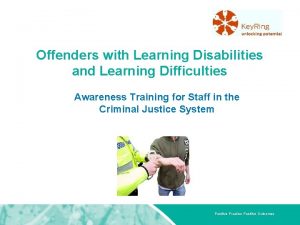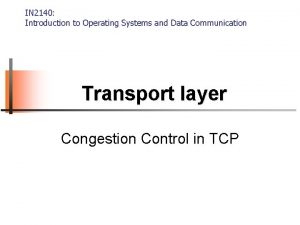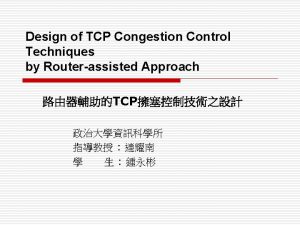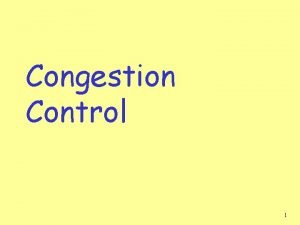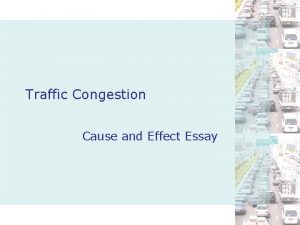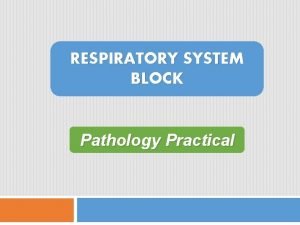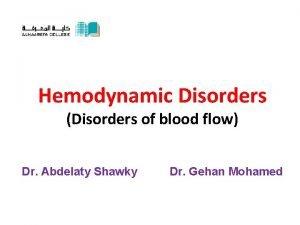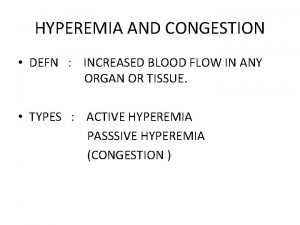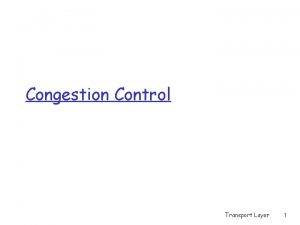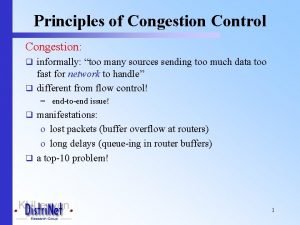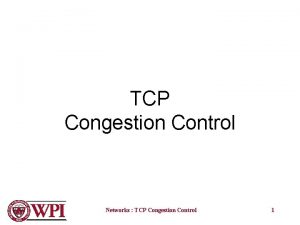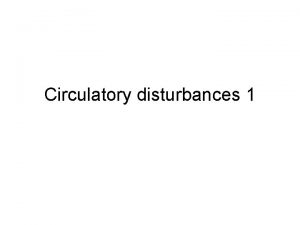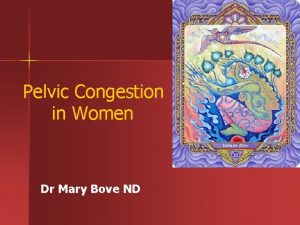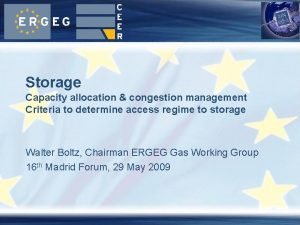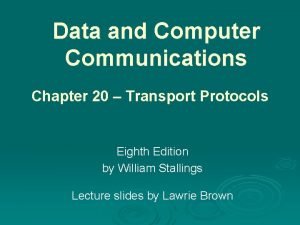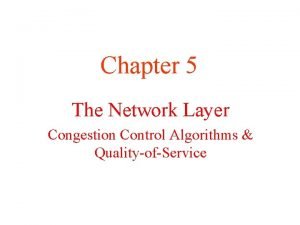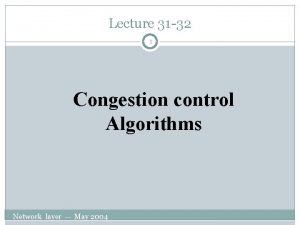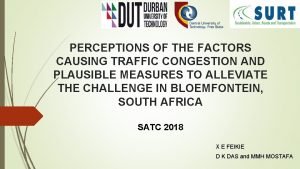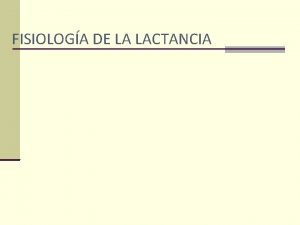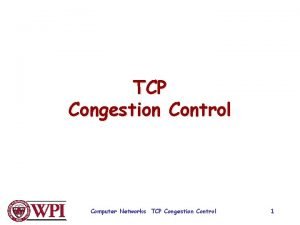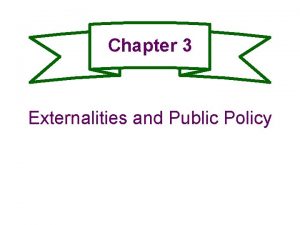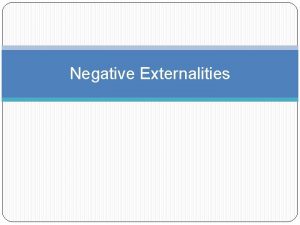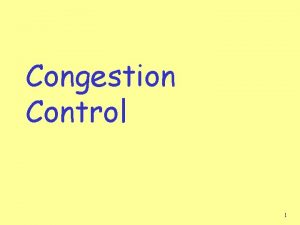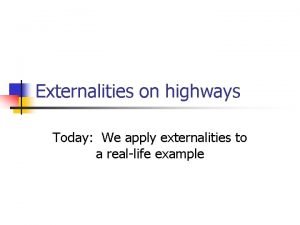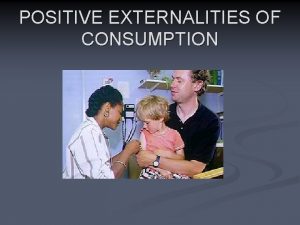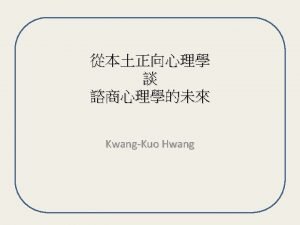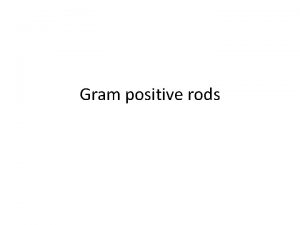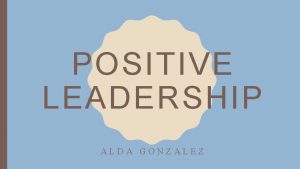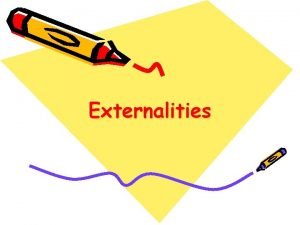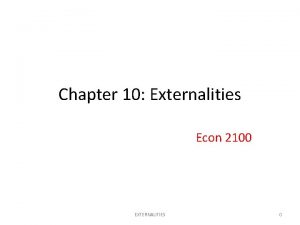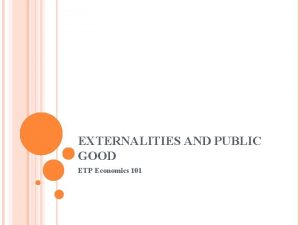More on externalities Today Positive externalities Highway congestion














































- Slides: 46

More on externalities Today: Positive externalities Highway congestion Problems

Previously: Introduction to externalities n Markets are well functioning for most private goods q q q n Many buyers and sellers Little or no market power by anybody Example: When demand shifts right for a good, new equilibrium will have higher price and quantity Some markets do not have good mechanisms to account for everything in a market q Example: Talking on a cell phone in an airplane

Previously: Introduction to externalities n n n n A simple algebraic example Graphical analysis of externalities Coase Theorem Public responses to externalities Pigouvian taxes in action Emissions fees Inefficiencies of uniform reductions Cap-and-trade

Today: More on externalities n Positive externalities q n An application q n What do we do when externalities are good? Externality problems of highway congestion More problems

Externalities can be positive n n n Remember that not all externalities are negative Some consumption leads to external benefits to others Recall some examples q q q Planting flowers in your front lawn Scientific research Vaccination n Prevents others from getting a disease from you

Positive externalities and subsidies n Subsidies can be used to increase efficiency in the presence of positive externalities q q Note that this money must be generated from somewhere, probably taxes Recall that tax money used for subsidies has its own deadweight loss n n Compare DWL with efficiency gains from the subsidy See Figure 5. 13, p. 101

Moving onto congestion n n Although we just talked about positive externalities, highway congestion is one of the worst negative externalities that exists Let’s examine the problem and potential solutions

Congestion externalities n n Congestion is a big problem in urban areas Possible solutions to the problem q q Tolls on congested routes Building our way out of congestion HOV lanes Private highways and express lanes n q Monopoly power? Public transit and city design

A simple example n Choose between a highway and a bridge

More information on this example n n n Travel time on the highway is 20 minutes, no matter how many other cars travel on this route The bridge is narrow, and so travel time is dependent on the number of other cars on the bridge If 1 car is on the bridge, travel time is 10 minutes; 2 cars, 11 minutes; 3 cars, 12 minutes; etc. q Travel time is 9 + T minutes if T represents the number of cars on the bridge

Route choice and externalities n Without tolls, equilibrium occurs with equal travel times on both routes q n 11 cars on the bridge However, there are negative externalities involved whenever an additional car travels on the bridge q Imposition of a one-minute negative externality to cars already on bridge

Why charging a toll is useful n Without tolls, the bridge and highway have the same travel times in equilibrium q n Take away the bridge and nobody’s travel time changes No social value to the bridge With tolls, some people can have shorter travel times q Lower overall travel time improves efficiency

Aren’t tolls costs too? n n If bridge tolls go to government, these are just transfers of money Toll revenue can offset tax money that has to be collected q Remember that taxes have DWL, except in a case like this where negative externalities are present n In this case, an optimal tax (which is a toll in this case) can reduce DWL q Known as double dividend hypothesis (More on this in Chapter 15)

Equilibrium with tolls n Suppose each minute has $1 in time costs, and a $5 toll is charged q q n Cost to travel on HW $20 Cost to travel on bridge time cost + $5 What is equilibrium? q Each person on the bridge has $15 in time cost travel time of 15 minutes 6 cars on the bridge

In the following analysis… n n …we assume 30 cars that must travel from A to B How many cars should travel on the bridge to minimize total travel time?

For efficiency, see the right column # on bridge Travel time on bridge Total minutes for bridge travelers Total minutes for highway travelers Total minutes for all drivers 1 10 10 580 590 2 11 22 560 582 3 12 36 540 576 4 13 52 520 572 5 14 70 500 570 6 15 90 480 570 7 16 112 460 572 8 17 136 440 576 9 18 162 420 582 10 19 190 400 590 11 20 220 380 600

What is efficient? 5 or 6 on bridge # on bridge Travel time on bridge Total minutes for bridge travelers Total minutes for highway travelers Total minutes for all drivers 1 10 10 580 590 2 11 22 560 582 3 12 36 540 576 4 13 52 520 572 5 14 70 500 570 6 15 90 480 570 7 16 112 460 572 8 17 136 440 576 9 18 162 420 582 10 19 190 400 590 11 20 220 380 600

The above example with calculus n Total travel time for all cars q q n 20 (30 – T) + (9 + T) T 600 – 11 T + T 2 First order condition to minimize travel time q q q – 11 + 2 T = 0 T = 5. 5 Is this a minimum or maximum? n Try second order condition

The above example with calculus n Second order condition to check that this is a minimum q 2>0 n n Positive second order condition Minimum Since fractional numbers of cars cannot travel on a route, we see that 5 or 6 cars minimizes total travel time

There are many highways out there n How does this problem generalize to the real world? q q Externality problems still exist on congested highways There are many ways to try to solve this problem

One possible solution: Private highways n n n Let’s look at a short video on LA traffic WARNING: This video is produced by reason. tv, an organization that advertises “Free minds and free markets” After the video q q I would like your thoughts about whether or not you believe the suggestions in the video will help solve our commuting problems We will discuss benefits and costs about private highways

Real traffic problems n n Los Angeles metro area Some refer many of these freeways to be parking lots during rush hours

Can we build our way out? n n Some people believe that we can build our way out of congestion Let’s examine this problem in the context of our example

Increased capacity on bridge n n New technology leads to bridge travel time at 9 + 0. 733 T Equilibrium without tolls: T = 15, 20 minute travel times for all once again

Increasing bridge capacity n n Increased capacity leads more people to travel on the bridge Increasing freeway capacity creates its own demand q n Some people traveling during non-rush hour periods will travel during rush hour after a freeway is expanded Freeway expansion often costs billions of dollars to be effective during peak travel periods

HOV lanes n n HOV lanes attempt to increase the number of people traveling on each lane (per hour) These attempts have limited success q q q Benefit of carpool: Decreased travel time, almost like a time subsidy Cost of carpool: Coordination costs Problem: Most big cities on the west coast are built “horizontally” sprawl limits effective carpooling

Private highways n n n Uses prices to control congestion Private financing would prevent tax money from having to be used More private highways would decrease demand for free roads

Problems with private highways n Monopoly power q q n n n Positive economic profits if not regulated Clauses against increasing capacity on parallel routes Loss of space for expansion of “free” lanes Contracts are often long (30 -99 years) Private highways are often built in places with low demand q Tollways in Orange County

Public takeover of a private highway n This is what happened on the 91 Express Lanes in Orange County (eventually) q Privately built n q Monopoly problems Public buy-out of the privately-built lanes n With public control, more carpooling has been encouraged

Pricing public roads n n n Pricing based on time of day and day of week can improve efficiency by decreasing congestion Recall that these measures increase efficiency Why are these “congestion pricing” practices not used more? q q Feasibility Political resistance

Benefits of congestion pricing n n Gasoline taxes can be reduced in congested areas to offset congestion pricing Pricing increases efficiency q n n Taxes may increase efficiency in this context Non-commuting traffic has an economic incentive to travel during times of little or no congestion Trips with little economic value can be avoided q Remember: With externalities, these trips have Social MB lower than Social MC

Example: 91 Express Lanes toll schedule $9. 55 toll going eastbound on Thursdays, 3 pm hour

Public transit and city design n People often hope that public transit is the solution q However, many people hope that “someone else” takes public transit n q Why? Slow, inconvenient, lack of privacy Public transit can only be a long-term solution if it is faster and less costly than driving n Public transit will almost always be less convenient than driving

Public transit and city design n City designs usually make public transit difficult for many people to use effectively q q q Sprawl leads to people originating travel in many different places Express buses are difficult to implement Local buses are slow, used mostly by people with low value of time

Public transit and city design n City planners can make public transit more desirable q q q Increased population density near public transit Areas with big workplace density, especially near bus routes and rail lines Designated bus lanes to make bus travel faster than driving solo

Public transit and city design n The problem with these potential solutions q q n People in these cities want their single family homes, low density neighborhoods People value privacy highly This leads to the externality problems of congestion

Summary: Congestion externalities n Congestion is a major problem in urban areas q n Congestion pricing has been implemented on a limited basis in recent decades in California q n Especially in cities built “horizontally” Feasibility and political resistance has limited further implementation Many other methods are used to try to limit congestion q Mixed success

Problem on externalities n Assume the following: Private MC is P = Q + 100; demand is P = 500 – Q; there is an external cost of 50 for each unit produced q q q What is the equilibrium if there are no market interventions? What is the efficient outcome? What is the deadweight loss in this equilibrium?

Problem on externalities n Assume the following: Private MC is P = Q + 100; demand is P = 500 – Q; there is an external cost of 50 for each unit produced q What is the equilibrium if there are no market interventions? n n n Here, the external cost is not accounted for in the equilibrium outcome Q + 100 = 500 – Q Q = 200 Next, find P: P = 500 – 200 = 300

Problem on externalities n Assume the following: Private MC is P = Q + 100; demand is P = 500 – Q; there is an external cost of 50 for each unit produced q What is the efficient outcome? n n With the external cost, social MC is (Q + 100) + 50, or Q + 150 Efficient outcome: Set the right hand sides of the social MC and demand curves equal to each other q Q + 150 = 500 – Q Q = 175

Problem on externalities n Assume the following: Private MC is P = Q + 100; demand is P = 500 – Q; there is an external cost of 50 for each unit produced q What is the deadweight loss in this equilibrium? n This is a triangle q q q Length of triangle is the difference between the quantities in the previous two parts: 200 – 175 = 25 Height of triangle is the external cost: 50 Area is ½ 25 50 = 625

Another problem on externalities n MB, or demand q n Marginal Private Cost q n MPC = Q + 580 Marginal damage (MD) q n MB = 3000 – Q MD = 0. 2 Q Marginal social cost q MSC = 1. 2 Q + 580

Another problem on externalities n What is Q 1? q n Set MB = MPC q q n Output with no negotiation or government control 3000 – Q = Q + 580 Q = 1210 Price is 3000 – Q, or 1790

Another problem on externalities n What is the socially efficient output? Q* q Set MB = MSC n n 3000 – Q = 1. 2 Q + 580 Q = 1100

Another problem on externalities n n What is the deadweight loss without controls? See dark red triangle Length of triangle q Difference of two quantities n n Height of triangle q MD at Q 1 = 1210 n n 1210 – 1100 = 110 0. 2 (1210) = 242 Area of triangle: half of length times height q 0. 5 110 242 = 13310 DWL triangle is 13310

How would you solve congestion?
 Lirik lagu more more more we praise you
Lirik lagu more more more we praise you More more more i want more more more more we praise you
More more more i want more more more more we praise you Pincuegula
Pincuegula Externalities problems and solutions
Externalities problems and solutions Define network externalities
Define network externalities Deadweight loss with positive externality
Deadweight loss with positive externality Externalities in environmental economics
Externalities in environmental economics Network externalities
Network externalities Pure public good
Pure public good Today's lesson or today lesson
Today's lesson or today lesson In todays class
In todays class Today's lesson or today lesson
Today's lesson or today lesson Meeting objective
Meeting objective Fingerprint galton details
Fingerprint galton details For today's meeting
For today's meeting Blended family
Blended family A dollar today is worth more than a dollar tomorrow
A dollar today is worth more than a dollar tomorrow A dollar today is worth more tomorrow
A dollar today is worth more tomorrow Novobiocin test
Novobiocin test Negative numbers rules
Negative numbers rules Positive practice positive outcomes
Positive practice positive outcomes Circumcorneal congestion
Circumcorneal congestion Tcp congestion control
Tcp congestion control Catarrhal appendicitis
Catarrhal appendicitis Tcp congestion control
Tcp congestion control Principles of congestion control in computer networks
Principles of congestion control in computer networks Hop by hop choke packet
Hop by hop choke packet Tcp header
Tcp header Causes of traffic congestion essay
Causes of traffic congestion essay Pathology
Pathology Difference between hyperemia and congestion
Difference between hyperemia and congestion Congestion and hyperemia
Congestion and hyperemia Principles of congestion control
Principles of congestion control Spleen congestion
Spleen congestion Principles of congestion control
Principles of congestion control Congestion
Congestion Chronic passive congestion of liver
Chronic passive congestion of liver Dr mary bove
Dr mary bove Capacity allocation and congestion management
Capacity allocation and congestion management Tcp congestion control
Tcp congestion control Congestion control in network layer
Congestion control in network layer Congestion control in virtual circuit
Congestion control in virtual circuit Traffic congestion conclusion
Traffic congestion conclusion Pletora mamaria
Pletora mamaria General principles of congestion control
General principles of congestion control Heart failure cells are seen in lungs
Heart failure cells are seen in lungs Network provisioning in congestion control
Network provisioning in congestion control


